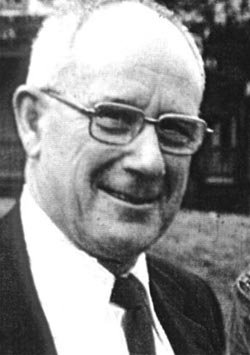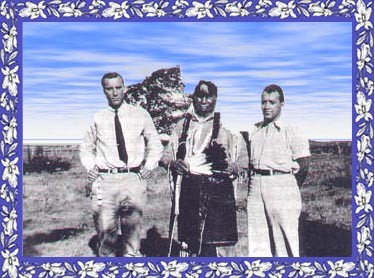Mushroom Pioneers
Chapter 2. Richard Evans Schultes
 |
Richard Evans Schultes (1977) |
Mushrooms collected by Schultes (1939, 1940, 1978) and Schultes and Reko, were later identified as Stropharia cubensis Earle, Psilocybe caerulescens Heim and some specimens of Psilocybe mexicana Heim which were mixed and confused by the presence of another mushroom identified as Panaeolus campanulatus var. sphinctrinus. After these mushrooms were deposited in the herbarium at Harvard, confusion surrounded their botanical identification and their equivalence with the sacred mushroom of the Aztecs until the early 1950's (these discoveries will be discussed in Chapter Three).
Richard Evans Schultes is a most remarkable man. He is one of the pioneers involved in identification of New World shamanic plants, especially those from Mesoamérica and the Amazonia of Colombia in South America. His research into psychoptic plants is undoubtedly the most extensive ever undertaken by any botanical scientist.
Richard Evans Schultes, Jeffrey Professor of Biology and Director of the Botanical Museum of Harvard University (Emeritus), is a native Bostonian. Not merely a botanical explorer, he is a noted ethnobotanist and conservationist. Among his numerous awards are the Cross of Boyacá, Colombia's highest honor, and the annual Gold Medal of the World Wildlife Fund, presented by H.R.H. the Duke of Edinburgh; in 1987, he received the prestigious Tyler Prize for Environmental Achievement.
His crowning achievement however, was the receipt of botany's Nobel Prize---the Gold Medal of the Linnean Society at London in 1992. Schultes is also on the exclusive list of 50 "Foreign Members" of that in itself exclusive society.
His explorations and botanical identification of thousands of plants from Amazonia is as immense as it is eclectic. During his fourteen years in the Amazon, Schultes had collected more than 24,000 plants new to science of which over 80 are entheogenic (Davis, 1996). He has also written more than two dozen books and over 100 scientific articles on his discoveries. He is, moreover the only living ethnobotanist to have more than two million acres of land named in his honor; Sector Schultes, part of an Amazonian ecological preserve formally designated in 1986 by the Colombian government.
The field of ethnobotany was Schultes' framework throughout his life. His field work in Oaxaca, México in 1938 and 1939 was somewhat limited due to the Second World War. However, he made history by pioneering the study of shamanic mushrooms of the Mazatec Indians.
Richard Evans Schultes was born in Boston, Massachusetts on January 12, 1915. When he was about six years old, Schultes developed an illness which caused him severe stomach problems. During this period, his father and mother would read to him and one book which caught Schultes' attention was Richard Spruce's "Notes of a Botanist on the Amazon and Andes." This was young Schultes' introduction to the world of botany.
As a young child, Richard once read a floral guide given to him by an uncle and after studying it, would collect leaves to identify and press. It seems that this helped the young collector develop what some people refer to as "the taxonomic eye."
In 1936, Schultes was just another premedical undergraduate student at Harvard University and one of his classes was Biology 104. While attending a course on "Plants and Human Affairs", Schultes was assigned to read a book by Heinrich Klüver entitled "Mescal: The Divine Plant and its Psychological Effects." Unbeknownst to Schultes, this assignment was destined to change the course of his entire life.
Previously unaware of peyote, Schultes soon began to develop a burning desire to experience mescaline firsthand. Schultes met with his professor, Oake Ames, and soon found himself with funding (most of which came directly from the pocket of his mentor Ames). Eventually Schultes met Weston LaBarre, a young student from Duke University in North Carolina who also shared an interest in peyote (LaBarre went on to become an anthropology professor and the author of The Peyote Cult, the definitive book on the peyote religion and The Ghost Dance: The Origins of Religion).
Together, Schultes and LaBarre traveled to Oklahoma where both participated in a Native American Church peyote-ceremony with the Kiowa Indians. There Schultes consumed the sacred cactus on which he then wrote his senior honors thesis.
Schultes soon decided that economic botany was the study he would pursue, so he completed his graduate work on the medicinal plants of Oaxaca, México. Schultes interest in Oaxacan plants came from having read some of the selected writings of the 16th and 17th century Spanish friars and historians who mentioned the existence of innumerable medicinal plants, some of a psychoactive nature, including the morning-glory seeds known as ololiuhqui.
 |
Fig. 2. Richard Evans Schultes,
a Kiowa shaman, and Weston LaBarre |
As noted previously, the first mushrooms collected by Schultes and Reko fit the botanical description of Panaeolus campanulatus var. sprinctrinus. In his 1939 and 1940 papers on the identification of the visionary Nahua mushroom, Schultes alleged that the mushrooms mentioned by the Spanish chroniclers probably belonged to the genus Panaeolus. It was important for these scientists to collect and identify the species they believed were the Aztec teonanácatl, yet they couldn't find anyone to perform for them a shamanic mushroom ceremony such as they suspected continued being held in secret. According to Schultes (1969), "so few mushrooms were gathered, because of the unusually dry season, that it was not possible for me to ingest them experimentally; all were needed as voucher herbarium specimens."
Another mushroom Schultes collected among the Sierra Mazateca was known by the Mazatec Indians as kee-sho. This mushroom at the time was incorrectly identified by Rolf Singer as Stropharia cubensis Earle. Schultes later collected specimens of Stropharia cubensis from dung after heavy rainfalls.
It was later determined that Schultes' identification of the mushroom known as kee-sho actually fit the taxonomic description of Psilocybe caerulescens var. mazatecorum Heim, a mushroom employed by Mazatec shamans in religious healing ceremonies. However, Schultes did collect Stropharia cubensis in Oaxaca in the late 1930's, but could not find any reference to its use prior to the conquest. It is not known if this species occurred in the new world until after the Spanish brought cattle onto the continent, most probably from India, the Philippines or possibly from Africa---although this species does occur in the manure of other ruminants. It is also probable that Stropharia cubensis was not one of the mushrooms being used by Aztec shamans and referred to as teonanácatl. Singer later amended this species to Psilocybe cubensis (Earle) Singer. Schultes (1978) later wrote: "subsequent studies by R. Gordon Wasson, R. Singer, R. Heim and Gastón Guzmán, have indicated that Stropharia (Psilocybe) cubensis Earle is one of the more important sacred Mexican mushrooms" in use today.
In Palenque, México, it is referred to as San Isidro Labrador (St. Isidore the Plowman), so aptly named for a patron saint of agriculture of old México. Even though it is common in most regions throughout Southern México and Central America, there are many shamans who consider it inferior to other varieties and many do not use it professionally except when other species are not available. One possible reason it may be avoided is that it grows in manure; more likely this is simply because it is not pre-Colombian and associated with the offal of the conquistadores cattle.
Schultes then presented to the scientific community numerous references to the use of inebriating mushrooms by Mesoamérican shamans and others. Schultes reported in his 1939 and 1940 papers that several codices not only had described the existence of the sacred mushrooms, but had also vividly described observed effects on people who had consumed the mushrooms, thereby verifying their (the mushrooms) existence and use. Thus Schultes paved the way, so to speak, for the Wassons and others eventually to follow his footsteps, when he published these findings (Schultes, 1939, 1940, see also, Schultes, 1987).
Schultes' research and oftentimes tedious hard work into the realm of the shamanic mushrooms soon drew to a close as other events directed him to the heart of the vast Amazonian forest to study dart poisons and rubber. As the war years dragged on, the sacred mushrooms of México once again fell back into the shadows of oblivion. Nevertheless, Schultes' doctoral thesis on the medicinal plants of Oaxaca and his two published papers on teonanácatl (Schultes, 1939, 1940), eventually found their way into the hands of an interested reader, R. Gordon Wasson, a fifty-four-year old Banker with Morgan Guaranty Trust. Wasson, along with his wife Valentina Pavlovna Wasson was able to accomplish that which Schultes had been unable to ingest the shamanic mushrooms of the Mazatecs (see Allen, 1987, 1997a).

